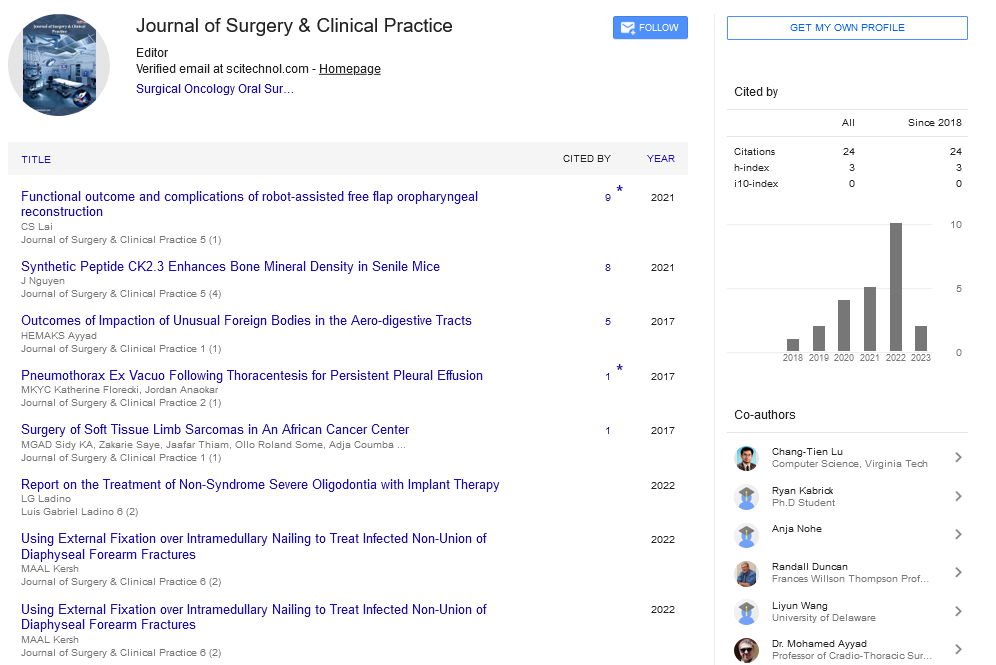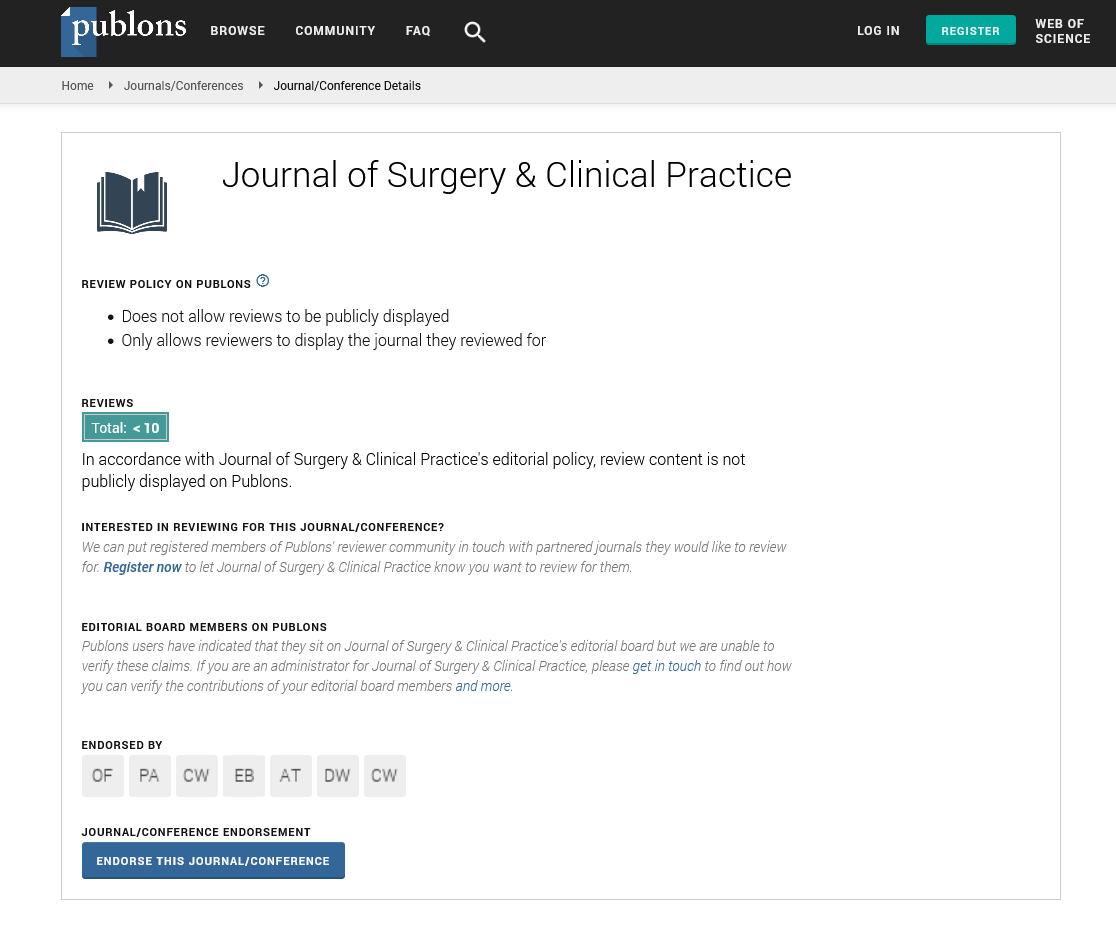Short Communication, J Surg Clin Prac Vol: 7 Issue: 4
Surgical Advances in Kidney Transplantation Methods
John Mathews*
1 Department of Surgery, Bahir Dar University, Bahir Dar, Ethiopia
*Corresponding Author: John Mathews,
Department of Surgery, Bahir Dar
University, Bahir Dar, Ethiopia
E-mail: john46@mathews.et
Received date: 22 November, 2023, Manuscript No. JSCP-23-120799;
Editor assigned date: 24 November, 2023, Pre QC No. JSCP-23-120799 (PQ);
Reviewed date: 08 December, 2023, QC No. JSCP-23-120799;
Revised date: 15 December, 2023, Manuscript No JSCP-23-120799 (R);
Published date: 22 December, 2023, DOI: 10.35248/ JSCP.23.7.100403.
Citation: Mathews J (2023) Surgical Advances in Kidney Transplantation Methods. J Surg Clin Prac 7:4.
Description
Kidney transplantation stands as a hope for individuals with End- Stage Renal Disease (ESRD). Over the years, surgical advances in kidney transplantation have transformed this life-saving procedure into a routine yet highly sophisticated intervention [1-3]. The history of kidney transplantation is marked by milestones reflecting the evolving understanding of immunology, surgical techniques, and postoperative care. The first successful kidney transplant, performed in 1954 by Dr. Joseph Murray, laid the foundation for subsequent advancements. Since then, surgical innovations have played a pivotal role in enhancing the success rates and expanding the pool of potential donors. One of the notable surgical advances in kidney transplantation is the widespread adoption of living donor kidney transplants. This approach not only addresses the shortage of deceased donor organs but also offers several advantages, including better organ quality, reduced cold ischemia time, and improved outcomes [4]. Minimally invasive laparoscopic techniques for donor nephrectomy have further minimized postoperative complications, enabling more individuals to become living donors.
In recent years, the integration of robotic-assisted surgery into kidney transplantation has garnered attention for its precision and minimally invasive nature. Robotic platforms, such as the da Vinci Surgical System, allow for enhanced dexterity and visualization, facilitating meticulous vascular anastomoses and reducing warm ischemia time [5,6]. Robotic-assisted kidney transplantation represents a frontier in surgical innovation, aiming to optimize outcomes and enhance donor and recipient experiences. Single-Incision Laparoscopic Surgery (SILS) has emerged as another breakthrough in kidney transplantation. This technique involves making a single small incision through which the entire transplant procedure is conducted. SILS reduces the cosmetic impact of surgery, minimizes pain, and accelerates recovery. This approach exemplifies the commitment to improving the patient experience while maintaining surgical efficacy.
Ex vivo normothermic perfusion is revolutionizing kidney transplantation by providing a platform for organ preservation and assessment outside the body. This technique allows surgeons to assess the viability of organs and optimize their condition before transplantation. By maintaining organs at body temperature, the risk of ischemia-reperfusion injury is mitigated, leading to better-functioning kidneys post-transplant [7,8]. Advances in desensitization protocols have expanded the pool of potential recipients by overcoming immunological barriers. Highly sensitized patients, who were once considered difficult to match due to high levels of pre-existing antibodies, can now undergo transplantation through desensitization techniques that reduce antibody levels and prevent rejection.
These protocols have significantly improved the chances of successful kidney transplantation for individuals facing immunological challenges. Refinements in vascular anastomosis techniques have contributed to improved blood flow and reduced complications in kidney transplantation. The development of novel sutureless or stapling devices has facilitated more efficient and secure connections between the donor and recipient blood vessels [9]. These innovations aim to enhance the patency of blood vessels, ensuring optimal function of the transplanted kidney. Surgical advances in kidney transplantation are complemented by innovations in immunosuppressive strategies.
Tailored immunosuppression protocols, including the use of induction therapies and maintenance regimens, help prevent rejection while minimizing the risk of complications. The pursuit of personalized medicine in immunosuppression aims to optimize outcomes by balancing the need for immunosuppression with the risk of infection and other adverse effects [10]. As technology continues to evolve and our understanding of transplantation biology deepens, the future holds promise for further enhancements in surgical approaches, ultimately improving the lives of countless individuals awaiting the gift of a new kidney.
References
- Garcia GG, Harden P, Chapman J (2012) The global role of kidney transplantation. Lancet 379:36-38.
- Morris P, Knechtle SJ (2008) Kidney transplantation: Principles and practice. Elsevier Health Sci.
- Legendre C, Canaud G, Martinez F (2014) Factors influencing long‐term outcome after kidney transplantation. Transpl Int 27:19-27.
- Knoll G (2008) Trends in kidney transplantation over the past decade. Drugs 68:3-10.
[Crossref]
- Evans RW, Kitzmann DJ (1998) An economic analysis of kidney transplantation. Surg Oncol Clin N 78:149-74.
- Kasiske BL, Snyder JJ, Matas AJ, Ellison MD, Gill JS, et al. (2002) Preemptive kidney transplantation: The advantage and the advantaged. J Am Soc Nephrol 13:1358-1364.
- Knoll GA (2013) Kidney transplantation in the older adult. Am J Kidney Dis 61:790-797.
- Jassal SV, Krahn MD, Naglie G, Zaltzman JS, Roscoe JM, et al. (2003) Kidney transplantation in the elderly: A decision analysis. JASN 14:187-196.
- Hariharan S, Israni AK, Danovitch G (2021) Long-term survival after kidney transplantation. NEJM 385:729-743.
- Perico N, Cattaneo D, Sayegh MH, Remuzzi G (2004) Delayed graft function in kidney transplantation. Lancet 364:1814-1827.
 Spanish
Spanish  Chinese
Chinese  Russian
Russian  German
German  French
French  Japanese
Japanese  Portuguese
Portuguese  Hindi
Hindi 
